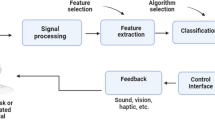Abstract
The world is innovating rapidly, and there is a need for continuous interaction with technology. Sadly, there do not exist promising options for paralyzed people to interact with the machines, i.e., laptops, smartphones, and tabs. A few commercial solutions such as Google Glasses are costly and cannot be afforded by every paralyzed person for such interaction. Towards this end, the paper proposes a retina-controlled device called EyeCom. The proposed device is constructed from off-the-shelf cost-effective yet robust IoT devices (i.e., Arduino microcontrollers, Xbee wireless sensors, IR diodes, and accelerometer). The device can easily be mounted on to the glasses; the paralyzed person using this device can interact with the machine using simple head movement and eye blinks. The IR detector is located in front of the eye to illuminate the eye region. As a result of illumination, the eye reflects IR light which includes electrical signals. As the eyelids close, the reflected light over the eye surface is disrupted, and the change in reflected value is recorded. Further to enable cursor movement onto the computer screen for the paralyzed person a device named accelerometer is used. The accelerometer is a small device, with the size of phalanges, a human thumb bone. The device operates on the principle of axis-based motion sensing and it can be worn as a ring by a paralyzed person. A microcontroller processes the inputs from the IR sensors, accelerometer and transmits them wirelessly via Xbee wireless sensor (i.e., a radio) to another microcontroller attached to the computer. With the help of a proposed algorithm, the microcontroller attached to the computer, on receiving the signals moves the cursor onto the computer screen and facilitate performing actions, as simple as opening a document to operating a word-to-speech software. EyeCom has features which can help paralyzed persons to continue their contributions towards the technological world and become an active part of the society. Resultantly, they will be able to perform a number of tasks without depending upon others from as simple as reading a newspaper on the computer to activate word-to-voice software.









Similar content being viewed by others
References
Batts C, Andrews DL (2011) Tactical athletes: the united states paralympic military program and the mobilization of the disabled soldier/athlete. Sport Soc 14(5):553–568. https://doi.org/10.1080/17430437.2011.574350
Blouin D (2014) The internet of things could empower people with disabilities. https://www.cmswire.com/cms/internet-of-things/the-internet-of-things-could-empower-people-with-disabilities-026211.php. Accessed 19 Aug 2018
Bose D, Bibu RK, Shovon TM (2017) Home automation with eye-blink for paralyzed patients. http://dspace.bracu.ac.bd:8080/xmlui/handle/10361/9537. Accessed 18 Aug 2018
Chatzopoulos D, Bermejo C, Huang Z, Butabayeva A, Zheng R, Golkarifard M, Hui P (2017) Hyperion: a wearable augmented reality system for text extraction and manipulation in the air. In: Proceedings of the 8th ACM on Multimedia Systems Conference (MMSys’17). ACM, New York, NY, USA, 284–295. https://doi.org/10.1145/3083187.3084017
Chen T, Chiu MC (2018) J Ambient Intell Hum Comput 9:319. https://doi.org/10.1007/s12652-016-0396-x
Christopher & Dana Reeve Foundation (2018) State about paralysis, living with paralysis. https://www.christopherreeve.org/living-with-paralysis/stats-about-paralysis. Accessed 28 Aug 2018
EyeComTec (2015) Statics about paralysis. https://www.eyecomtec.com/3016-Statistics-about-Paralysis. Accessed 22 Aug 2018
Ha K, Chen Z, Hu W, Richter W, Pillai P, Satyanarayanan M (2014). Towards wearable cognitive assistance. In: Proceedings of the 12th annual international conference on mobile systems, applications, and services (MobiSys’14). ACM, New York, NY, USA, pp 68–81. http://dx.doi.org/10.1145/2594368.2594383
Karidis A (2016) New tool allows paralyzed to speak—using their eyes. https://www.washingtonpost.com/national/health-science/new-tool-allows-paralyzed-to-speak–using-their-eyes/2016/04/04/a1dc1d98-da50-11e5-925f-1d10062cc82d_story.html?utm_term=.73218d0ddd32. Accessed 18 Aug 2018
Kerdjidj O, Ramzan N, Ghanem K et al (2019) J Ambient Intell Hum Comput. https://doi.org/10.1007/s12652-019-01214-4
Malasinghe LP, Ramzan N, Dahal KJ (2019) Ambient Intell Hum Comput 10:57. https://doi.org/10.1007/s12652-017-0598-x
Mann S (2013) Wearable Computing. In: Soegaard M, Dam RF (eds.) The encyclopedia of human-computer interaction (2nd ed.). Aarhus: the interaction design foundation. http://www.interaction-design.org/encyclopedia/wearable_computing.html. Accessed 19 Aug 2018
Masai K, Sugiura Y, Suzuki K, Shimamura S, Kunze K, Ogata M, Inami M, Sugimoto M (2015) AffectiveWear: towards recognizing affect in real life. In: Proceeding ACM international joint conference on pervasive and ubiquitous computing, ACM, New York, NY, USA, pp 357–360. https://doi.org/10.1145/2800835.2800898
Piltch A (2011) The time for wearable computers has finally arrived. https://www.laptopmag.com/articles/the-time-for-wearable-computers-has-finally-arrived. Accessed 24 Dec 2018
Pols H, Oak SB (2007) War & military mental health: The US psychiatric response in the 20th century. Am J Public Health 12: 2132–42. https://search-proquest-com.marshall.idm.oclc.org/docview/215094374?accountid=12281. Accessed 17 May 2018
Ranger S (2018) What is the IoT? Everything you need to know about the Internet of Things right now | ZDNet. https://www.zdnet.com/article/what-is-the-internet-of-things-everything-you-need-to-know-about-the-iot-right-now/. Accessed 21 Nov 2018
Sliney D, Aron-Rosa D, DeLori F, Fankhapatient F, Landry R, Mainster M (2005) Adjustment of guidelines for exposure of the eye to optical radiation from ocular instruments: statement from a task group of the International Commission on Non-Ionizing Radiation Protection (ICNIRP). Appl Opt 44(11):2162. https://doi.org/10.1364/ao.44.002162
Tran L (2016) The importance of the internet of things for Project management. https://www.inloox.com/company/blog/articles/the-importance-of-the-internet-of-things-iot-for-project-management/. Accessed 29 Mar 2018
US Department of Health, (2017) Tongue-operated devices help paralyzed people. https://www.nibib.nih.gov/news-events/newsroom/tongue-operated-devices-help-paralyzed-people. Accessed 18 Aug 2018
Wahl F, Amft O, Freund M (2015) Using smart eyeglasses as a wearable game controller. In: ACM international joint conference on pervasive and ubiquitous computing, https://doi.org/10.1145/2800835.2800914
Yu C-H, Peng W-W, Yang-Mao S-F, Wang Y, Chinthammit W, Duh H (2015) A hand gesture control framework on smart glasses, pp 1–1. https://doi.org/10.1145/2818427.2819695
Zhang L, Li X-Y, Huang W, Liu K, Zong S, Jian X, Feng P, Jung T, Liu Y (2014) Demo: visual attention driven networking with smart glasses. In: Proceedings of the annual international conference on mobile computing and networking, MOBICOM. https://doi.org/10.1145/2639108.2641739
Author information
Authors and Affiliations
Corresponding author
Additional information
Publisher's Note
Springer Nature remains neutral with regard to jurisdictional claims in published maps and institutional affiliations.
Rights and permissions
About this article
Cite this article
Malik, H., Mazhar, A. EyeCom: an IoT based affordable wearable solution for paralyzed people to interact with machines. J Ambient Intell Human Comput 11, 2325–2336 (2020). https://doi.org/10.1007/s12652-019-01358-3
Received:
Accepted:
Published:
Issue Date:
DOI: https://doi.org/10.1007/s12652-019-01358-3




